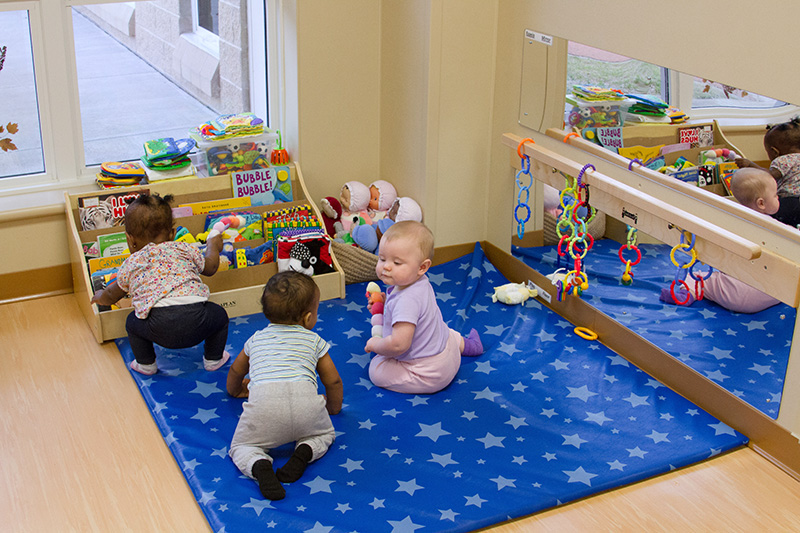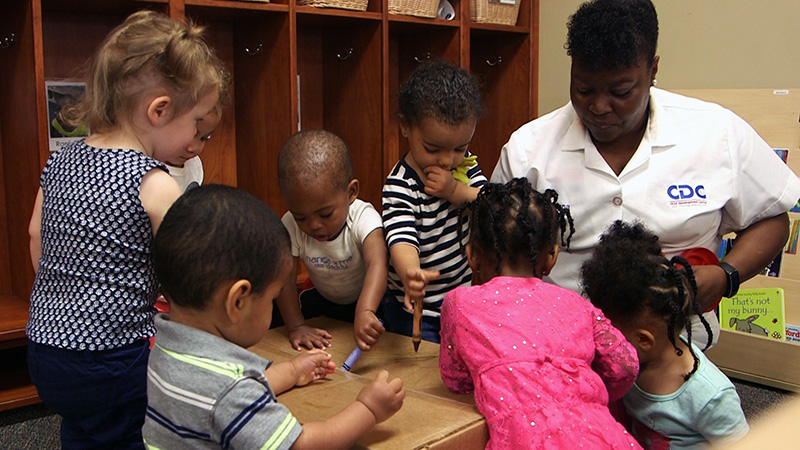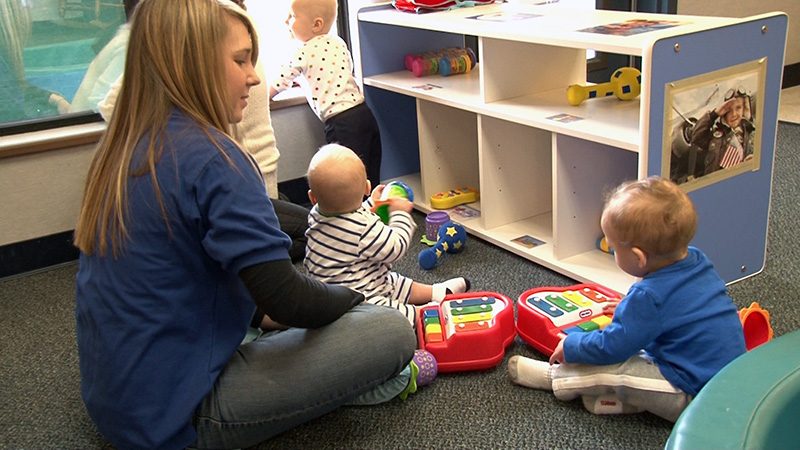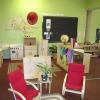- Recognize the effects of learning environments on infants and toddlers.
- Identify features of environments that help infants and toddlers feel secure, comfortable, welcome, and ready to explore and learn.
- Describe how to design and maintain a safe and developmentally appropriate environment for infants and toddlers.
- List potential learning areas found in infant or toddler environments.
Learn
Know
How Do Environments Affect You?
When you choose to visit a favorite restaurant, a local park, a sporting arena, or a good friend’s home, you likely feel good about these experiences because you enjoy them. What is it about those places that make you feel welcome or secure? Thinking about these places might ignite certain positive feelings related to the experience (things you see, feel, hear, or smell).
Now consider places you do not like to go. Environments like the dentist’s office, the airport, or a noisy restaurant may be less pleasant for you. In some settings, we feel relaxed and comfortable, yet in others, we might feel tense, overwhelmed, and confused. Environments can affect us in many different ways. They can influence how we feel, what we do, and the ways we respond in certain situations. Some of us dislike places where we feel we cannot control or predict our experiences. In some spaces, we may feel like we do not belong or are not appreciated.
As with adults, infants and toddlers are affected by their environments, even if they cannot yet tell us directly how they feel. It is our job to ensure learning spaces make infants and toddlers feel welcome, secure, and ready to learn.
Designing Your Space to Meet Infants’ and Toddlers’ Needs
Families are infants’ and toddlers’ first and primary teachers. However, many infants and toddlers spend time in care settings outside of their homes. Experiences during the first few months and years of life are critical because they set the stage for the child’s future development and learning. The quality of these early experiences is shaped by the individuals and environments with which infants and toddlers spend their time. Thus, the infant and toddler learning environment must provide a flexible climate that supports child-directed practices, spontaneous exploration, curiosity, and the creation and maintenance of positive relationships between adults and children. As such, the learning environment is an essential component of curriculum for infants and toddlers.
Creating a supportive learning environment requires time, reflection, and planning. An emotionally supportive environment helps prepare infants and toddlers for learning (Bagdi & Vacca, 2005), and may be especially important for at-risk children who may not have high-quality relationships outside the learning space. Military children are a particular group that may experience a great deal of change in their daily lives so the supportive learning environment you provide can be an important source of consistency for them. A supportive environment is well-organized, dependable, and flexible.
Supportive environments send children a variety of positive messages about their learning (Dodge et al., 2010), such as:
- This is a good place to be.
- You belong here.
- You can trust this place.
- There are places where you can be by yourself when you want to be.
- You can do many things on your own here.
- This is a safe place to explore and try out your ideas.
Watch the video to see examples of ways these messages appear in learning environments.
Messages Our Environments Send
Environments affect how we feel and send messages about how to act. They can influence what we learn. The Reggio Emilia approach to early-childhood education recognizes the tremendous impact of the environment by referring to it as the “third teacher” (with parents and teachers as children’s first and second teachers, respectively). The Reggio Emilia approach was developed by Loris Malaguzzi and named after an area in Italy. This approach demonstrates that children are powerful learners and that their interests should guide adults’ decisions surrounding learning, including how the environment is arranged and what materials are provided. The Reggio Emilia approach believes the learning environment plays a critical role, and that intentionality (thoughtful planning and action) on behalf of teachers in the design of spaces and the selection and arrangement of materials significantly influences children’s level of engagement and learning (Edwards, 2002). We will revisit this approach to early childhood education in future lessons in this course.

Special Considerations for Working With Infants and Toddlers
The Role of Relationships on the Environment
The infant and toddler learning environment includes many interrelationships:
- Caregiver–family
- Caregiver–child
- Caregiver–caregiver
- Administrator/trainer/coach–caregiver
- Child-child
Each of these relationships affect infants and toddlers and each should be equally supported. Although adults often assume infants and toddlers are too young to understand what happens between adults in their environment, recent research shows that they can quickly recognize tension between adults (Du Rocher Schudlich, White, Fleischhauer, & Fitzgerald, 2011). Such tension could mean some infants and toddlers spend eight or more hours in stressful environments. Positive, respectful relationships among all adults in a program affect the emotional climate for everyone—children, staff, and families (McMullen & Dixon 2009).
Keeping Infants and Toddlers Safe
Safe and secure environments promote positive interactions between children and adults, and allow caregivers to devote their time to playing and developing relationships rather than keeping children away from hazards. In a safe environment, attentive caregivers who are aware of infant and toddler needs, can help them move about freely, explore, and play with materials that are sturdy, in good repair, and a safe size. Mobile infants develop rapidly. Their increasing motor skills require caregivers to be alert and anticipate their actions and possible new hazards, such as reaching things they could not reach before. Toddlers are incredibly curious and may not be fully aware of what is dangerous. Caregivers must support and balance exploration and curiosity with a careful eye and use simple language to explain what is safe and unsafe. Caregivers must also complete ongoing safety checks and provide families with information about keeping young children safe at home. For more information on safe and appropriate materials for infants and toddlers, please see this section’s Materials lesson and the Safe Environments course.
Understanding What is Developmentally Appropriate
Caregivers can support the natural desire of infants and toddlers to actively explore their environment with their whole body by knowing about this age group’s development. Having this knowledge helps caregivers better understand and predict what interactions, materials, and experiences will be safe, engaging, and most supportive to best promote learning and development. The courses on cognitive, physical, social emotional, creative, and self will help build and strengthen teachers' understanding of infant and toddler development.
Knowing Individual Characteristics
Caregivers can be most responsive when they understand the strengths, interests, and needs of each individual child in their care. Knowing the individual characteristics of infants and toddlers enables caregivers to offer adaptations essential for children with various temperaments and special needs.
Connecting With Families
Caregivers should take time to connect with families to better understand their backgrounds, values, beliefs, expectations, goals, hopes, and dreams. This offers caregivers the opportunity to create learning environments that include interactions and experiences that are respectful, supportive, and meaningful for infants, toddlers, and their families. Children’s experiences at home and in their communities influence their reactions to care and learning environments. The environment you design should represent and respect the children’s abilities, traditions, and backgrounds. Understanding the infant’s or toddler’s background, language, and experiences can help caregivers create a more familiar and comfortable care and learning environment.
Supporting Caregivers’ Needs
Although the focus of supportive learning environments for infants and toddlers is on the children, supportive environments also consider and accommodate the needs of caregivers. Caring for infants and toddlers is rewarding but can also be tiring. The environment should be set up to make the caregiver’s job as easy as possible. For example, adult-sized rocking chairs allow caregivers to provide responsive care while feeding infants or rocking them to sleep. Storage spaces for adult personal items (e.g., purse, coat), may help reduce anxiety about children’s safety. If possible, caregivers should have a quiet space such as a lounge in which they can take breaks from their work and recuperate their physical and emotional energy. Such spaces can also be used for private conversations between caregivers and parents.
Regular communication with your trainer, coach, or administrator will help you maintain a supportive learning environment and allow you to consider different methods and processes for reflecting on and further examining your space. Environmental rating tools are surveys completed by observers that examine and help provide an overall picture of the environment that has been created. These tools, such as the Infant-Toddler Environmental Rating Scale (Harms, Clifford, & Cryer, 2017), can be used by staff to gather information about an environment to support caregivers, improvements, and approaches to infant and toddler development and learning. You can ask your trainer, coach, or administrator for more information on the kinds of tools your program uses to assess or provide feedback on indoor and outdoor environments.
Creating Developmentally Appropriate Spaces for Infants and Toddlers
Infants and toddlers grow and develop both quickly and at their own pace. Environments must be created to meet their current and emerging developmental skills while keeping in mind the appropriateness and safety of the space and furniture.
Young infants react to the new world around them and need to feel secure in order to engage in exploration and learning. Caregivers can provide spaces and experiences that encourage trust and strengthen bonds, such as cozy spaces for caregivers to hold and care for infants.
Mobile infants have a strong desire to move and explore. Caregivers should provide spaces that are safe, clean, and stimulating. Soft, thick floor coverings, such as vinyl mats, will help mobile infants feel comfortable moving on the floor. Adding features such as tunnels to the environment will encourage further development of motor skills and exploration. Offering safe furniture upon which infants or toddlers can pull themselves up and cruise or creep along is also helpful.
Toddlers are learning to focus their attention on desired experiences. Caregivers can offer a variety of materials and sensory experiences to support toddlers (e.g., sand and water table, sound area). Learning areas should be organized to foster toddlers’ developing independence. Materials should be placed on low, open shelves and labeled with pictures and words. Toddlers will avoid frustration when they can find what they need and want.

For rooms with only young infants, setting up specific learning areas may not be appropriate, as the entire room forms the learning area for infants. However, caregivers should offer a variety of experiences and materials and should be prepared to rotate materials and experiences or rearrange spaces when children’s developmental needs change. Keep in mind that offering too many materials at one time may overstimulate children. It is important to explore the environment from the perspective of infants and toddlers e.g., crawl around on your hands and knees or lay on the floor to understand how well it functions for very young children.
Creating Learning Areas for Infants and Toddlers
Using the environment to support development for infants and toddlers helps caregivers concentrate on specific experiences. A learning area is an area within an infant-toddler room that allows caregivers to support particular developmental domains (e.g., a climbing or grasping area to assist with gross or fine motor development) or exploration of certain ideas (e.g., a block area to explore cause-and-effect and balance). Although learning areas may be designed to support particular aspects of development or interests, they should not be used exclusively for one purpose. Rather, learning areas should include many engaging possibilities, with each area serving multiple functions. For example, a cozy book area, not only provides young children with early-literacy experiences, but also provides a quiet, calm space to relax alone or with a caregiver.
Learning areas must be accessible and adaptable for all children. Young infants will need caregivers to bring them materials. Mobile infants and toddlers will have the ability to take materials or toys with them across the entire room, and others may need adaptive equipment to explore the space.
Learning areas to consider when creating infant or toddler rooms:

Carefully consider how learning areas are arranged next to one another. Think about placing quieter learning areas next to each other or near the napping space, or anticipating how infants and toddlers may want to use materials across learning areas. Freedom to move materials from one learning area to another provides infants and toddlers an opportunity to take charge of their learning and make their ideas come to life. For example, moving a dinosaur from the block area to the dramatic play area to be “washed” in the play sink offers toddlers a way to express their budding imaginative play.
See
When creating supportive indoor learning environments for infants and toddlers, there are many factors to consider. Watch this video for examples of messages infants and toddlers receive from supportive environments. What do you notice?
Supportive Learning Environments for Infants and Toddlers
Do
When designing and arranging learning environments to benefit infants, toddlers, and yourself, you should:
Completing This Course
For more information on what to expect in this course, the Learning Environments Competency Reflection, and a list of the accompanying Learn, Explore and Apply resources and activities offered throughout the lessons, visit the Infant & Toddler Learning Environments Course Guide.
Please note the References & Resources section at the end of each lesson outlines reference sources and resources to find additional information on the topics covered. As you complete lessons, you are not expected to review all the online references available. However, you are welcome to explore the resources further if you have interest, or at the request of your trainer, coach, or administrator.
Explore
Using the information you have learned from this lesson, examine your environment while considering the question “If I were an infant or toddler…?”.
Complete the Environments Affect Behavior activity by answering questions about each space in your learning environment. Share your responses with your trainer, coach, or administrator
Apply
Use the Tools to Use attachment to help you arrange and rearrange your environment—all without breaking a sweat! Take a moment to review the resources below and revisit as needed to ensure you are creating a safe, comfortable, and stimulating space for the infants and toddlers in your care.
Glossary
Demonstrate
Bagdi, A., & Vacca, J. (2005). Supporting early childhood social-emotional well-being: The building blocks for early learning and school success. Early Childhood Education Journal, 33, 145-150.
Biermeier, M. A. (2015). Inspired by Reggio Emilia: Emergent curriculum in relationship driven learning environments. Young Children, 70(5). https://www.naeyc.org/resources/pubs/yc/nov2015/emergent-curriculum
Bucher, E., & Pindra, S. (2020). Infant and toddler STEAM: Supporting interdisciplinary experiences with our youngest learners. Young Children, 75(2). https://www.naeyc.org/resources/pubs/yc/may2020/infant-and-toddler-steam-supporting-interdisciplinary-experiences.
Dodge, D., Rudick, S., Berke, K. (2015). The Creative curriculum for infants, toddlers, and twos (3rd ed.). Teaching Strategies, Inc.
Du Rocher Schudlich, T. D., White, C. R., Fleischhauer, E. A., & Fitzgerald, K. A. (2011). Observed infant reactions during live interparental conflict. Journal of Marriage and Family, 73(1), 221-235.
Gillespie, L.G., Greenburg, J.D. (2017). Rocking and rolling: Empowering infants’ and toddlers’ learning through scaffolding. Young Children, 17(2). https://www.naeyc.org/resources/pubs/yc/may2017/rocking-and-rolling-empowering-infants-and-toddlers
Harms, T., Clifford, R. M., & Cryer, D. (2017). Infant/toddler environment rating scale (3rd ed.). Teachers College Press.
Lally, J. R. (2004). Infants have their own curriculum: A responsive approach to curriculum planning for infants and toddlers. Child Care Resources. http://ccrnj.org/wp-content/uploads/2015/06/Infants-Have-Their-Own-Curriculum.pdf
Luckenbill, J., Subramaniam, A., & Thompson, J. (2019). This is play: Environments and interactions that engage infants and toddlers. National Association for the Education of Young Children.
McMullen, M. B., & Dixon, S. (2009). In support of a relationship-based approach to practice with infants and toddlers in the United States. In Brownlee, J. (Ed.). Participatory Learning and the Early Years (pp. 109-128). Routledge.
Nemeth, K. (2020). Rocking and rolling. Nurturing infants and toddlers with diverse language experiences. Young Children. 75(2). https://www.naeyc.org/resources/pubs/yc/may2020/rocking-and-rolling
Petersen, S. H. & Wittmer, D.S. (2018). Infant and toddler development and the responsive program planning: A relationship-based approach (4th ed.). Pearson.
Shonkoff, J. P., & D. A. Phillips (2000). From neurons to neighborhoods: The science of early childhood development. National Academies Press.


